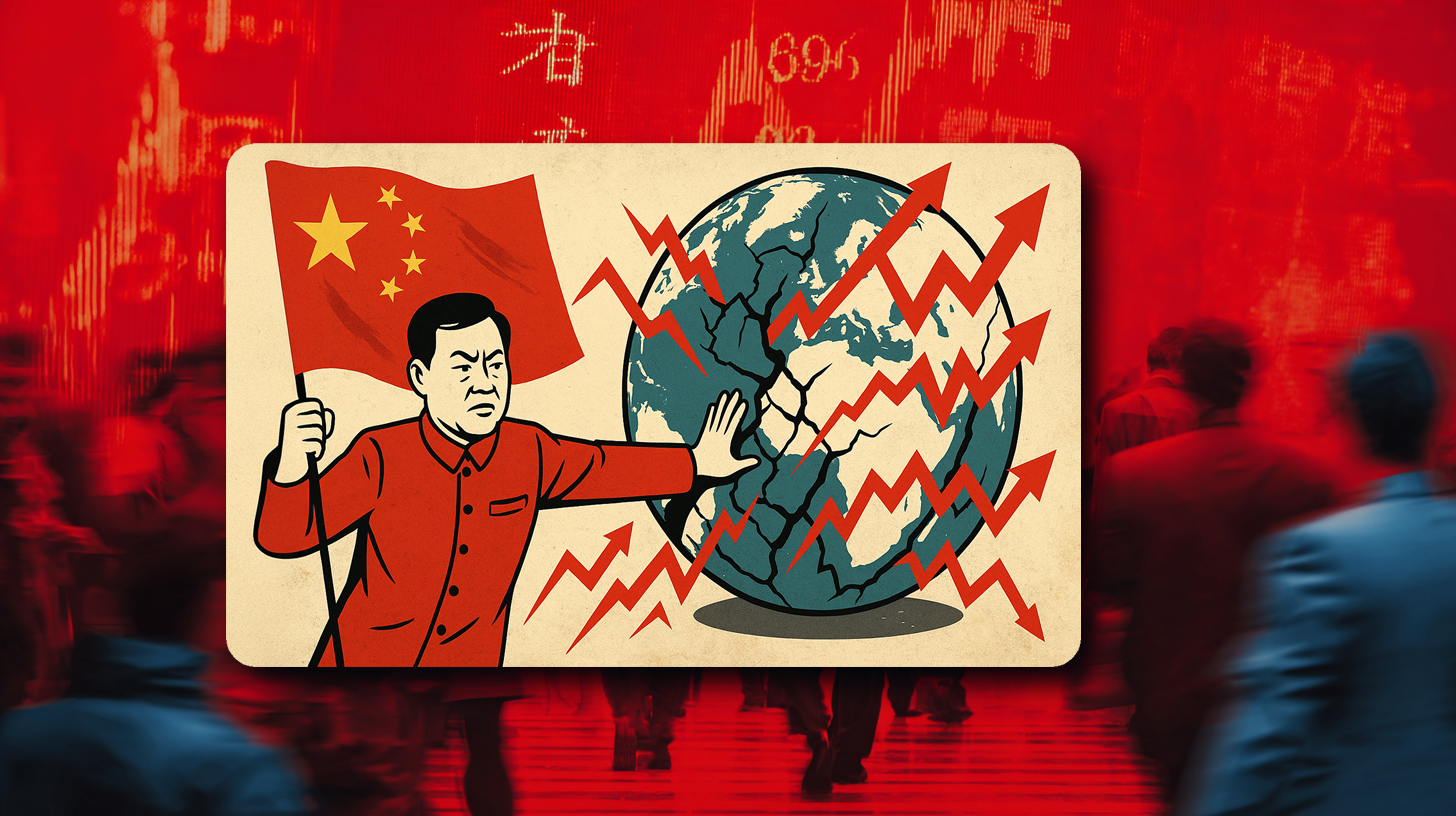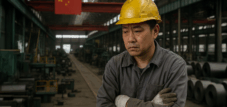
China's "disorderly competition" – The fight against self-destructive economic dynamics (Politburo meeting on July 30, 2025) – Image: Xpert.Digital
Xi Jinping's new mission: China's fight against disorderly competition – and what it means for the world
China's secret economic crisis: What "Neijuan" really means and why Beijing is acting now
China's economy, long synonymous with unstoppable growth, faces a profound challenge internally referred to as "neijuan" (内卷, "involution"). This term, which originally described the stagnation of over-managed agriculture, has become a viral buzzword in recent years, outlining a self-destructive spiral of excessive competition and diminishing marginal returns. It is a phenomenon in which ever-increasing resources are expended without achieving proportional progress or real growth—a condition that reinforces the sense of overwork, stress, and hopelessness in Chinese society.
What began as a social observation has now escalated into a central problem of economic policy. The situation is particularly explosive in the so-called "New Three" (新三样) – solar modules, electric vehicles, and lithium batteries. These sectors, once celebrated as China's future growth drivers, have fallen victim to massive overcapacity and a ruinous price war. Manufacturers are systematically selling below cost, thereby destabilizing entire value chains and endangering the companies' very existence. The numbers speak volumes: solar production capacity that far exceeds global demand, price wars in the e-car market reminiscent of the collapsed real estate industry, and battery capacities that could meet global demand until 2035 – all of these are symptoms of Neijuan.
The Chinese leadership under President Xi Jinping recognized the urgency and officially declared war on Neijuan at the Politburo meeting on July 30, 2025. Combating "disorderly competition" became one of the three main priorities for the second half of 2025. This marks a turning point in which Beijing is deviating from its previous subsidy policy and initiating "Supply-Side Reform 2.0" with administrative interventions, industry self-regulation, and fiscal measures. However, the structural causes—a principal-agent dilemma between central and local governments that fuels subsidy races, and a decentralized system in which unprofitable companies expand with state aid—remain deeply rooted. China's path out of this self-destructive dynamic will be long and complex, with far-reaching consequences for the global economy.
Suitable for:
- China's electric car industry is heading for historic consolidation – and is even forcing market leader BYD to flee
Neijuan – China’s fight against self-destructive economic dynamics
Since 2020, Neijuan (内卷, "involution") has become a central concept in China's economic policy. At the Politburo meeting on July 30, 2025, the Chinese leadership under President Xi Jinping officially declared war on the phenomenon and made combating "disorderly competition" one of the three main priorities for the second half of 2025.
What does Neijuan mean?
Neijuan describes a destructive cycle of excessive competition in which companies expend ever more resources without proportional progress or growth. The term originally comes from anthropology: Sociologist Clifford Geertz used "involution" in 1963 to describe agricultural stagnation in Indonesia, where productivity did not increase despite increasing labor input.
In China, the term was translated into Chinese around 2000 by the historian Huang Zongzhi and given an additional dimension: diminishing marginal returns with increasing labor input. Since 2020, neijuan has gone viral and became one of the top ten Chinese buzzwords of the year. Today, the concept describes a society engaged in a self-destructive race without real progress—a life characterized by overwork, stress, anxiety, and a sense of being trapped.
Neijuan in the economy: From society to industry
What initially began as a description of social conditions—particularly in the education system and labor market—increasingly translated into structural economic problems from 2024/2025 onward. In industry, neijuan manifests itself as a ruinous price war in which manufacturers systematically sell below cost, thereby not only endangering their own existence but also destabilizing entire value chains.
Particularly affected are the so-called "New Three" (新三样, xin san yang) – solar modules, electric vehicles, and lithium batteries. These sectors were originally identified as growth drivers and strategic industries of the future, but now suffer from massive overcapacity:
Solar industry
China's production capacity reached approximately 1,000 GW in 2023 and is expected to rise to 1,700 GW by 2026, with global demand of just 445 GW in 2023. The four largest Chinese module manufacturers (Longi, Jinko Solar, Trina Solar, JA Solar) reported combined net losses of 11 billion yuan (US$1.54 billion) in the first half of 2025 alone, a 150 percent increase over the previous year. In September 2025, production cuts led to a dramatic 48 percent increase in polysilicon prices, after prices had previously fallen to historic lows of US$0.07–0.09 per watt.
Electric vehicles
The Chinese electric car market is experiencing a brutal price war. In May 2025, market leader BYD cut prices for 22 models by up to 30 percent – the Seagull mini hatchback cost just the equivalent of $7,800. This triggered warnings that the industry could suffer a similar fate to the collapsed real estate industry. In September 2025, BYD reported declining sales in China for the first time in 18 months – a decline of 5.5 percent. BYD's net profit fell by 29.9 percent in the second quarter of 2025.
Batteries
Lithium-ion battery production capacity in China exceeded 2 TWh in 2024—60 percent higher than actual demand. Planned capacities exceed 6 TWh, enough to meet global demand until 2035.
The structural causes: A systemic problem
Neijuan's roots lie in China's decades-old growth model, but it became particularly evident after the end of the real estate bubble in 2021-22. When investment in the real estate sector collapsed, Beijing had to find an alternative investment engine to sustain GDP growth. Instead of focusing exclusively on infrastructure, the government directed massive investment flows into manufacturing—particularly the strategic "New Three" sectors.
A key structural problem is the principal-agent dilemma between the central government and local authorities. Provincial and local governments are valued based on local economic performance, jobs, and tax revenues. This led to a subsidy race between regions, in which local governments invested in productive capacity regardless of macroeconomic rationality.
Chinese industrial policy differs fundamentally from Western approaches: First, local governments at the provincial, city, and district levels have considerable power and resources to support local companies—often in explicit competition with other Chinese regions. Second, entire value chains are subsidized, not just individual segments. This leads to a decentralized system in which numerous locally supported companies operate at a nationally unprofitable level but expand through subsidized costs, thereby driving down prices.
More than 99 percent of listed Chinese companies received government subsidies in 2022. However, studies show that subsidies drove only 1 percent of capital investment between 2019 and 2023 (compared to 6 percent between 2014 and 2018), while over 80 percent was driven by revenue growth. However, the dependence of the "New Three" companies is significantly higher: 22 percent of their new investments between 2019 and 2023 were made possible by subsidies.
Suitable for:
- China and the Neijuan of systematic overinvestment: State capitalism as a growth accelerator and structural trap
Beijing’s countermeasures: The “anti-involution” strategy
At the Politburo meeting on July 30, 2025, the Chinese leadership made combating Neijuan a core priority. This marked a significant turning point: for the first time, the term was used in a high-level policy document, following Premier Li Qiang's initial mention of it in his annual work report to the National People's Congress in March 2025.
The National Development and Reform Commission (NDRC) announced in August 2025 that it would crack down on "herd behavior" in investments in emerging sectors and curb "disorderly competition" and "overcapacity." The measures include:
Administrative interventions:
- Stricter price monitoring and planned bans on sales below cost
- Restrictions on new production facilities
- Closure of inefficient operations
- Curbing the subsidy race between provinces
- In silicon production, one third of the existing capacity is to be reduced
Industry self-regulation
In December 2024, 33 leading Chinese polysilicon and solar companies agreed to OPEC-style production cuts, with quotas based on market share and capacity. The China Photovoltaic Industry Association is advocating minimum module prices of 0.68 yuan per watt. Leading manufacturers are now producing at only 55-70 percent capacity.
Fiscal measures
Starting in the fourth quarter of 2025, China will eliminate the 13 percent value-added tax (VAT) rebate on exports of solar modules and energy storage systems. This will increase global prices by approximately 9 percent.
Perspective: Supply-Side Reform 2.0
The current strategy is called "Supply-Side 2.0" and differs from previous approaches. While the 2015 supply-side reforms relied on administrative closures and consolidation of state-owned enterprises in heavy industries such as steel and coal, the new approach pursues more market-oriented mechanisms: grid access rules, energy efficiency standards, financing discipline, and selective enforcement.
The fundamental challenge, however, remains: As long as political imperatives push local governments and state-owned enterprises to expand production—even if this means limiting household income relative to output—there will be more supply than demand. Beijing can shift this imbalance between sectors (from real estate to manufacturing, from low-tech to high-tech), but it cannot eliminate it without fundamental adjustments to the economic structure.
The Fourth Plenum of the 20th Central Committee in October 2025 will set the guidelines for the 15th Five-Year Plan (2026-2030). Whether Xi Jinping fundamentally rethinks his economic policy direction or continues with the current line will be revealed in these documents. The Chinese solar industry has cut 87,000 jobs, and more layoffs are expected – a sign that the fight against Neijuan is only just beginning.
Suitable for:
Your global marketing and business development partner
☑️ Our business language is English or German
☑️ NEW: Correspondence in your national language!
I would be happy to serve you and my team as a personal advisor.
You can contact me by filling out the contact form or simply call me on +49 89 89 674 804 (Munich) . My email address is: wolfenstein ∂ xpert.digital
I'm looking forward to our joint project.
☑️ SME support in strategy, consulting, planning and implementation
☑️ Creation or realignment of the digital strategy and digitalization
☑️ Expansion and optimization of international sales processes
☑️ Global & Digital B2B trading platforms
☑️ Pioneer Business Development / Marketing / PR / Trade Fairs
🎯🎯🎯 Benefit from Xpert.Digital's extensive, five-fold expertise in a comprehensive service package | BD, R&D, XR, PR & Digital Visibility Optimization
Benefit from Xpert.Digital's extensive, fivefold expertise in a comprehensive service package | R&D, XR, PR & Digital Visibility Optimization - Image: Xpert.Digital
Xpert.Digital has in-depth knowledge of various industries. This allows us to develop tailor-made strategies that are tailored precisely to the requirements and challenges of your specific market segment. By continually analyzing market trends and following industry developments, we can act with foresight and offer innovative solutions. Through the combination of experience and knowledge, we generate added value and give our customers a decisive competitive advantage.
More about it here:

